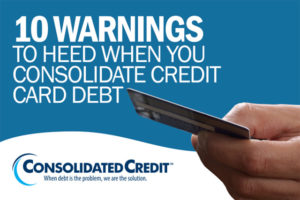I Consolidate My Credit Cards but Used Them Again
What is credit card consolidation?

Credit card consolidation refers to any solution that takes multiple credit card balances and combines them into a single monthly payment. The main goal is to reduce or eliminate the interest rate applied to the balance. This makes it faster and easier to pay off credit card debt. Instead of wasting money on interest charges, you can focus your money on paying off principal—that's the balance your actually owe. In many cases, you can get out of debt faster, even though you pay less each month. Credit card consolidation essentially gives you a more efficient way to eliminate debt.
Options for credit card consolidation
There is more than one way to consolidate credit card debt—in fact, there are three basic solutions. Two are do-it-yourself and involve taking out new financing to pay off your existing credit card balances. The second takes professional help. You set up a repayment plan through a credit counseling agency. But you still owe your original creditors.
- Acredit card balance transfer consolidates credit card debt by moving your existing balances to a new balance transfer credit card. These cards offer 0% APR introductory rates on balance transfers, giving you a limited time to pay off debt interest-free.
- With adebt consolidation loan, you take out an unsecured personal loan at a low interest rate. You use the funds from the loan to pay off your credit card balances. This leaves only the low-interest loan to repay. There is also a secured version of this where homeowners borrow against their home equity, but that can be risky.
- Adebt management program is basically a professionally-assisted debt consolidation program. You set up a repayment plan you can afford with the help of a certified credit counselor. Then they negotiate with your creditors to reduce or eliminate interest charges.
Identifying the best way to consolidate credit card debt out of these three options depends on your financial situation. That includes how much you owe, your credit score, and how much money you have available for monthly payments.
Step-by-step instructions for credit card debt consolidation
Now that you know what not to do and what you need to avoid when consolidating credit, you can start looking at how to consolidate credit card debt using each method. This will help you decide on the best way to consolidate given your financial situation.
Assessing your financial situation
This table can help you understand how to choose the best consolidation options for your needs.
| Balance Transfer | Debt Consolidation Loan | Debt Management Program | |
|---|---|---|---|
| Credit score needed | Very good-excellent (FICO 740 or higher) | Good-excellent (FICO 670 or higher) | Any score is eligible, including bad |
| Recommended debt range | Less than $5,000 | Less than $25,000 | $10,000 to $100,000+ |
| Interest rate | 0% APR introductory rate | Target less than 10% APR | Negotiated with each creditor; 0-10%, on average |
| Monthly payments | As high as possible to pay off balance quickly | Monthly payments may be lower than your total payment now | Total credit card payments reduced by up to 50% |
How to consolidate credit cards with a balance transfer

Balance transfers are the best option for credit consolidation when you have excellent credit and a limited amount of debt. Balance transfer cards offer 0% APR for a limited time after you open the account. The higher your score, the longer the 0% APR period.
The goal is to pay off your balance before the 0% APR period ends. Once it does, the regular APR for balance transfers will apply, so your rate will basically be right back up where you started.
- Shop for a balance transfer card that offers low fees and the longest 0% APR teaser rate; teaser rates usually apply for 6-18 months, depending on your credit score.
- Apply for the best card that you find. Only apply for one card, because filing multiple applications can decrease your credit score.
- Once you open the account, begin transferring your balances.You can call customer service or set them up online. You'll need the account numbers for all balances you wish to transfer.
- Be aware that there will be a fee applied for each balance transferred. Fees range from $3 per transfer to 3% of the balance transferred.
- With your balances consolidated, quickly pay down your debt.Ideally, you want to pay off the full balance before the teaser rate expires. So, divide your total balance by the number of months you have the teaser rate.
For example, let's say you owe $3,000 on three accounts. You open a balance transfer card that offers 0% APR for 12 months with a fee of $3 per transfer. You'd pay $9 to transfer the three balances, giving you a total balance of $3,009. To pay that balance off during the introductory period, you'd need to make payments of at least $250.75 per month.
How to consolidate credit card debt with a personal loan
Using a loan to consolidate credit card balances is another DIY option you can use if you have good credit. You take out a loan the lowest interest rate possible and use the funds you receive to pay off your credit cards. This leaves only the loan to repay.
This is often the best way to consolidate credit card debt if you want lower monthly payments. Depending on the term you choose, you can significantly reduce how much you pay each month. But you still get out of debt faster than you would with traditional payments thanks to the low APR.
- Shop around for the right debt consolidation loan.You want to aim for low APR, low fees and a term that will give you monthly payments you can afford.
- When you find the best loan for your needs, you apply.Only apply for one loan, because applying for multiple loans at once will hurt your credit score.
- Choose a term that offers monthly payments you can afford.A longer term means lower monthly payments, but higher total costs. A shorter term will reduce total costs, but it means higher monthly payments.
- Once approved, the funds are disbursed to pay off your credit card balances.In some cases, the lender will give you the money to disburse. In others, they'll pay your creditors directly.
- Pay off the loan with fixed payments.If the loan doesn't have any early repayment penalties, you can also make extra payments. For instance, pay off a big chunk of the debt with your next tax return.
Consolidating credit card debt through a debt management program

If you can't consolidate credit card debt on your own—either because you have a low credit score or too much debt for a DIY solution—then you need to call in professionals.
- Contact a nonprofit consumer credit counseling for a free debt evaluation. The credit counselor will review your debts, credit, and budget to see if you can use do-it-yourself solutions. If not, as long as you have the ability to make monthly payments, you can usually qualify for a DMP.
- Your credit counselor will help you find a payment that works for your budget.Set up and monthly administration fees will be rolled into this payment. Fees are capped at $79 nationwide and set based on state regulations where you live.
- Then the credit counseling team calls your creditors to negotiate. They negotiate to reduce or eliminate interest charges and stop penalties that may be getting applied to your debt.
- Once all your creditors agree to accept payments through the DMP, your plan starts.You make one payment to the credit counseling agency each month. They distribute the money to your creditors as agreed.
- You still owe your original creditors.The credit counseling agency is basically there to be your advocate and help ensure you can stick with the program.
During a debt management program, all credit card accounts you include will be frozen when you enroll. You won't be able to apply for new accounts during the program. But this can be beneficial because it helps you break any credit dependency that you've developed. The credit counseling team also helps you set a budget, so it's easier to live credit-free.
Not sure which consolidation option is right for you? Talk to a certified credit counselor for a free, no-obligation debt evaluation.
A real example of credit consolidation
Credit cards have relatively high interest rates compared to other types of debt. Credit consolidation solutions allow you to lower the interest rate applied to the balance. As a result, more of each monthly payment gets applied to the principal balance. This allows you to get out of debt faster, save money on interest charges, and—in many cases—lower the monthly payment.
Here's an example of how it works when you use a debt management program to consolidate. Let's say you have four credit cards.
| Current Balance | Interest Rate (APR) | Monthly Payment | |
|---|---|---|---|
| Credit card 1 | $4,002 | 20% | $160.08 |
| Credit card 2 | $3,375 | 17% | $135.00 |
| Credit card 3 | $4,846 | 21% | $193.84 |
| Credit card 4 | $3,475 | 14% | $139 |
Total current balance:$15,698
Average interest rate (APR):18%
Total monthly payment:$627.92
Estimated time to pay off total balance:11 years, 1 month
Total estimated interest charges: $8,912.98
Then you consolidate the debt with a debt management program. The credit counseling team works with your creditors, who agree to reduce the interest rates applied to your balances. They also agree to accept reduced monthly payments.
| Current Balance | New Interest Rate (APR) | New Monthly Payment | |
|---|---|---|---|
| Credit card 1 | $4,002 | 8% | $81 |
| Credit card 2 | $3,375 | 7% | $75 |
| Credit card 3 | $4,846 | 6% | $85 |
| Credit card 4 | $3,475 | 1.9% | $62 |
Total current balance:$15,698
New average interest rate (APR):5.73%
New monthly payment:$303
Time to pay off total balance:4 years, 10 months
Total estimated interest charges: $2,459.65
In this example, consolidation would:
- Lower your monthly payments by $324.92
- Allow you to get out of debt six years and three months sooner
- Save you $6,453.33 in interest charges
You still pay back the full balance owed, but you do it in a more efficient way by minimizing interest (APR). Consolidation lowers your monthly payments, the number of payments you need to make to become debt-free, and the total interest charges.
While balance transfers and debt consolidation work differently, the result is the same. You still minimize interest, combine your debts into one monthly payment, and enjoy the same benefits that you see in the example above.
If you have questions about debt consolidation or need help finding the best way to consolidate, talk to a certified credit counselor for free.
10 things to watch out for when you consolidate

Using credit card consolidation to become debt-free takes the right strategy and discipline. You need to make sure that it's the right fit for your situation and then follow through. Heeding these warnings can help you make sure that credit consolidation will be a successful solution for you. Always consider your financial situation carefully before you consolidate. If you're not sure if consolidation is right for you, call (844) 276-1544 to receive a free evaluation from a certified credit counselor.
10 Warnings to Heed When You Consolidate Credit Card Debt
These are the biggest pitfalls that consumers run into when they consolidate credit card debt.
Consolidating credit card debt in 2021
"The current financial crisis has created a unique situation for people considering credit consolidation," Consolidated Credit PresidentGary Herman explains. "The Federal Reserve has dropped interest rates as low as possible to encourage borrowing in a down economy. That's great for people thinking of getting loans to consolidate credit card debt.
"On the other hand, lenders have tightened lending standards, with tougher credit score and debt-to-income ratio requirements. That makes it harder for people to qualify to take advantage of those low rates."
Low rates are favorable for consolidation
During an economic downturn like the one we're experiencing now, the Federal Reserve will lower the Federal Funds Rate, which is the interest rate that financial institutions use to set their interest rates. The Federal Funds Rate is currently near zero—it ranges from 0.00 to 0.25.
That's good for consumers who want to borrow. Interest rates on various types of loans are much lower than they were before the downturn started. That means if you can qualify for a debt consolidation loan, you can enjoy a low rate. It's the qualification part that can be challenging.
Approvals are harder to come by
While the Federal Reserve wants to encourage borrowing in a down economy, lenders want to limit their risk. This means that they only want to extend loans to people that are likely to pay them back. They're understandably worried about defaults if people can't pay.
As a result, they "tighten" lending standards. This means you need a higher credit score and a lower debt-to-income ratio to qualify for new credit. This means that it's currently tougher to qualify for debt consolidation loans and balance transfer credit cards.
Limited terms on new credit
Another way that lenders and creditors protect against risk is to limit the terms they offer to new customers.
For lenders, this means that they may cap personal loan limits. Instead of allowing you to borrow up to $50,000, the lender may only offer $20,000 or lower, depending on your credit. If you are considering a credit consolidation loan, you need to make sure you can qualify for a loan amount large enough to pay off all your credit card balances.
For credit card companies, there are two ways that they limit terms during an economic downturn. One is to offer a lower credit limit on the card. The other is to reduce the 0% APR period you enjoy when you first open the account.
"Two years ago, credit card companies would offer 0% APR for up to 24 months on balance transfers," Herman explains. "These days, most creditors limit that introductory period to 12 to 18 months."
This is important for people considering getting a balance transfer card to consolidate. Let's say you want to consolidate $12,000 in credit card debt. With a 24-month 0% APR period, you could pay off the entire balance during the interest-free period with $500 payments. However, if the introductory period is only twelve months, you would need to pay $1,000 per month.
Does the downturn affect consolidation with a debt management plan?
"The good news is that the limitations that you see with do-it-yourself debt consolidation don't affect people who want to consolidate with a debt management plan," Herman says. "There are never any credit score or debt-to-income ratio requirements you must meet to enroll in a debt management program. You can use the program regardless of how low your credit score is or how much debt you need to consolidate."
This means that people who want to consolidate still have a way to do so even if they can't qualify for the do-it-yourself options.
"Credit card companies want to work with people," Herman encourages. "Working with a credit counseling organization like Consolidated Credit shows them that you're serious about pay back everything you charged on your credit cards. So, we can work with them to reduce or eliminate the interest charges applied to your balance and find a monthly payment that you can afford. It's a great way to consolidate for those who can't successfully consolidate on their own."
Consolidated Credit offers proven results in credit consolidation
In nearly 30 years, Consolidated Credit has helped consumers consolidate over $9.75 billion in credit card debt. In 2020 alone, we helped over 17,000 Americans consolidate over $232 million in credit card debt.
This map shows the average balance that consumers had in each state when they consolidated. You can also hover over each state to see how much debt we consolidated for clients in each state in 2020.
Keep in mind that we understand that credit consolidation is not the right solution for everyone. As we said in the introduction, this is not a financial silver bullet that will work in every situation.
As a nonprofit credit counseling organization, our certified credit counselors will only recommend a debt management program if it is the best debt solution to use in your situation. So, while we provided free credit counseling to over 628,000 people last year, only roughly 17,000 went on to consolidate with us.
For others, some received recommendations to apply for credit consolidation loans or balance transfer cards. If a counselor sees that you should be able to consolidate successfully on your own, they can confirm that for you.
In other cases, the people who received credit counseling were simply not a good fit for consolidation in their current situation. Many were facing unemployment and lost income. While credit consolidation may lower someone's monthly payments, those payments need to be made.
If you don't have the income to consolidate, then you may need to wait for your situation to improve or consider other debt relief options, such as bankruptcy.
Talk to a certified credit counselor to find the best credit consolidation option for your needs.
Source: https://www.consolidatedcredit.org/credit-card-debt/consolidation/